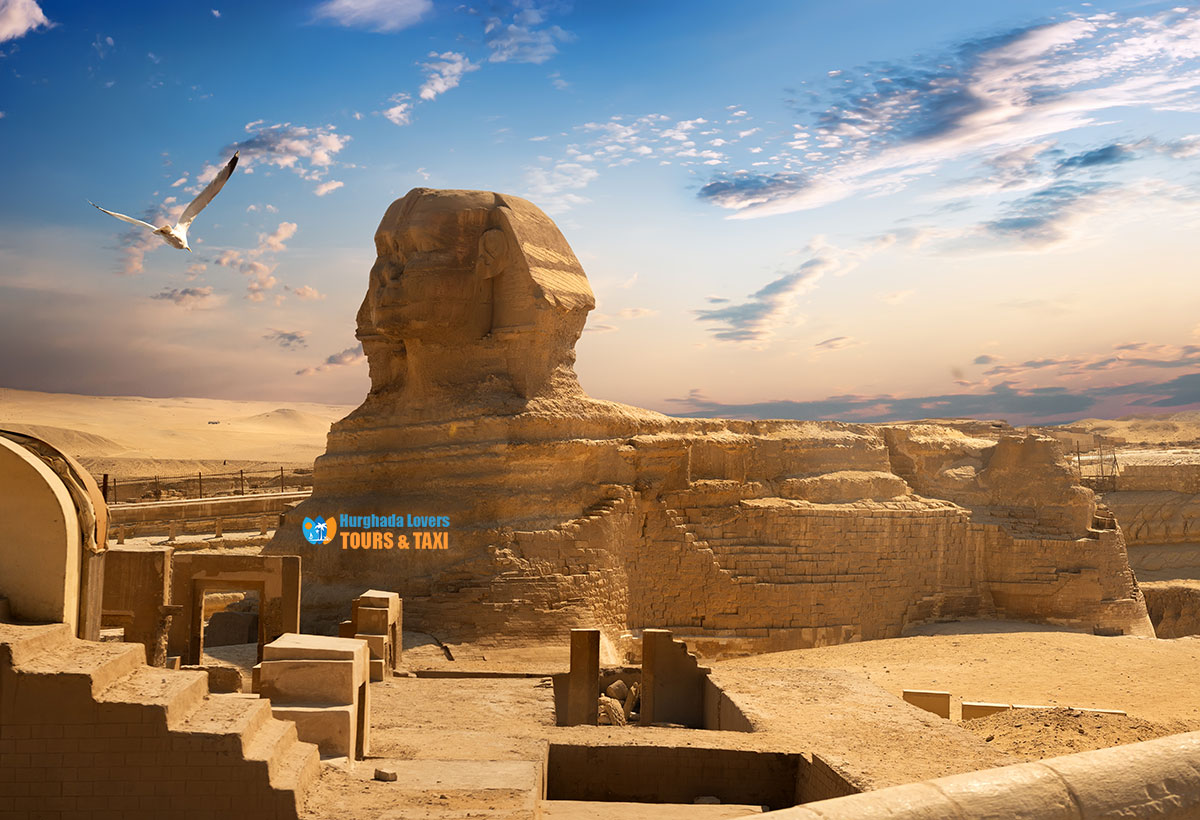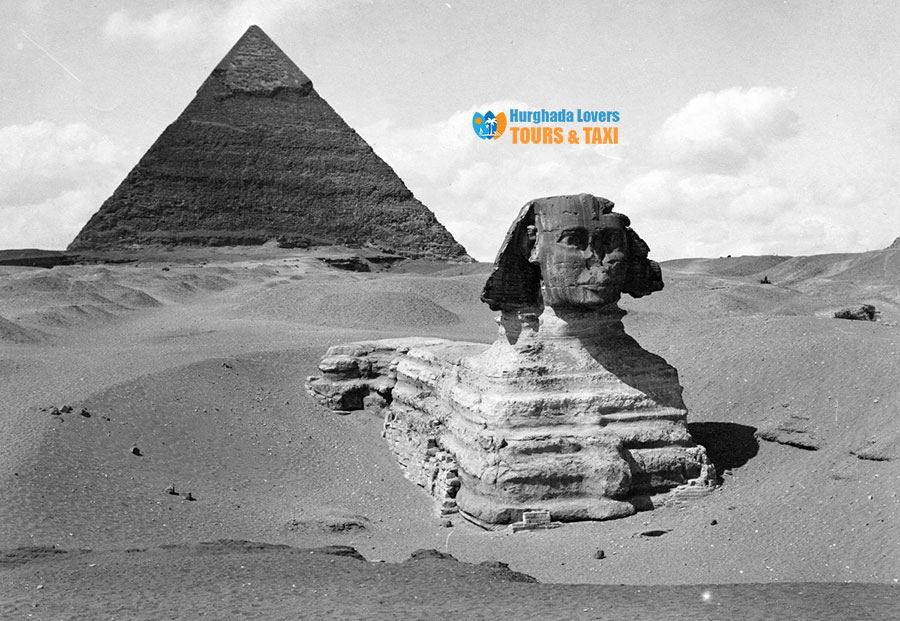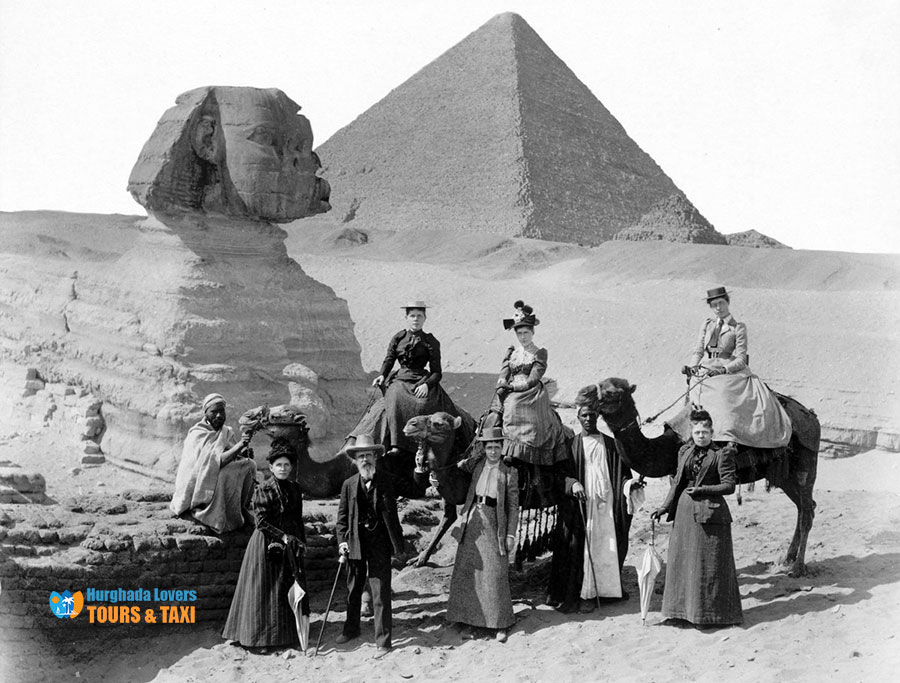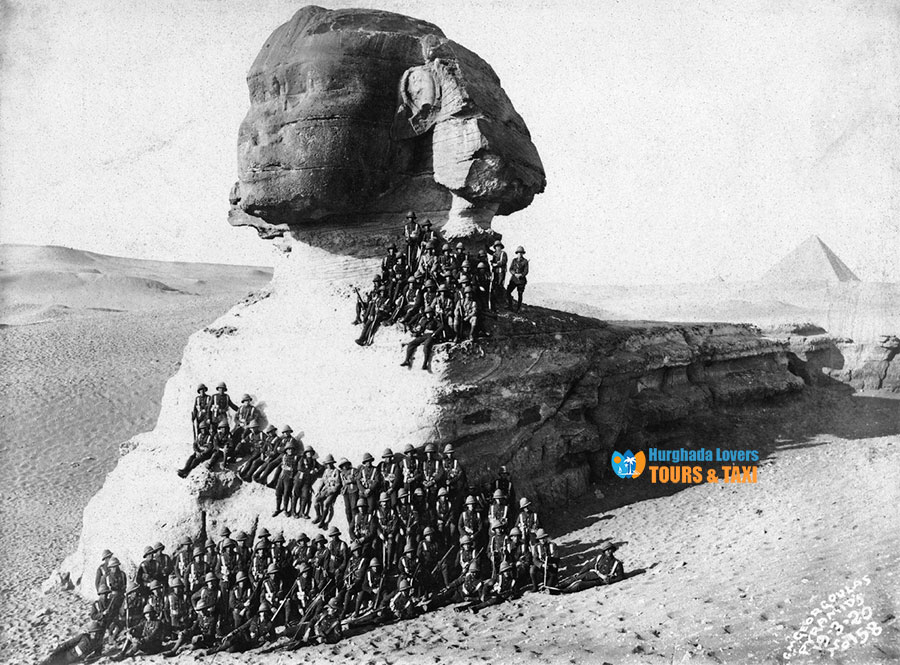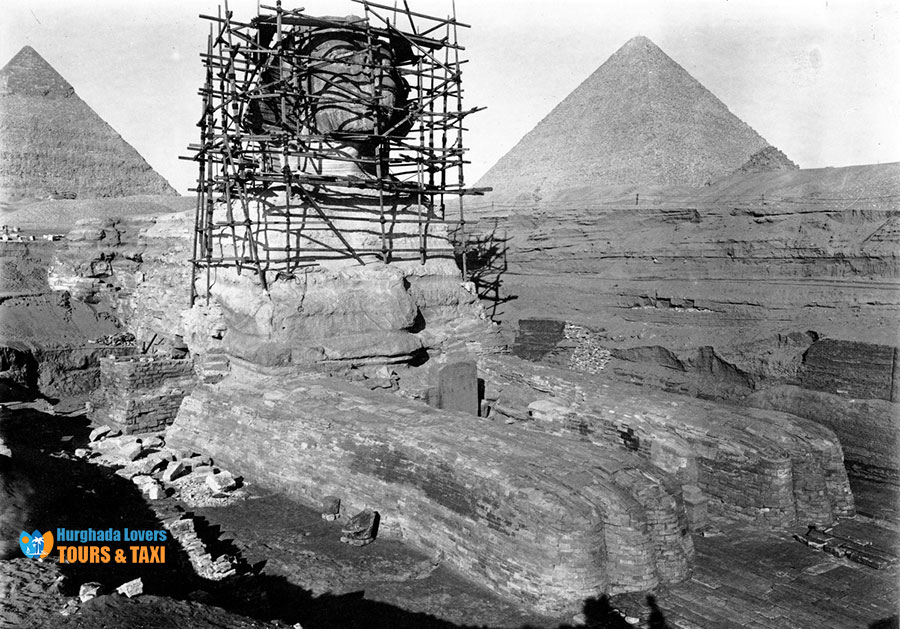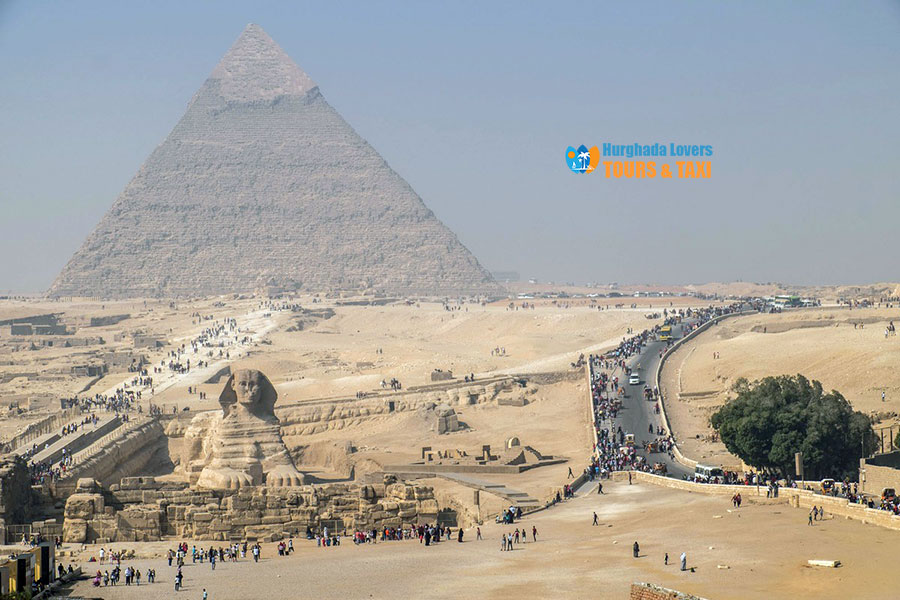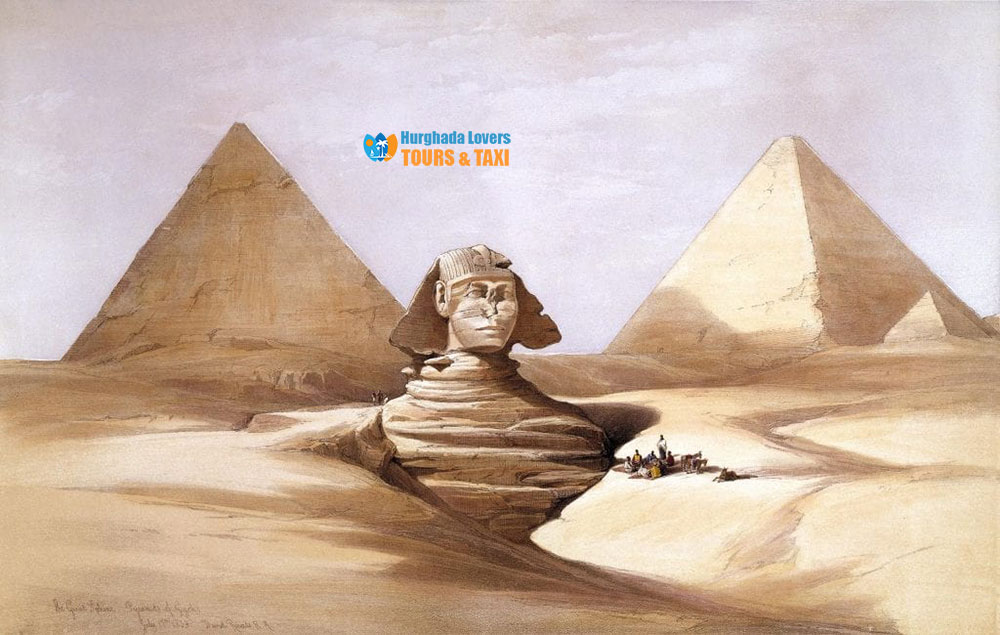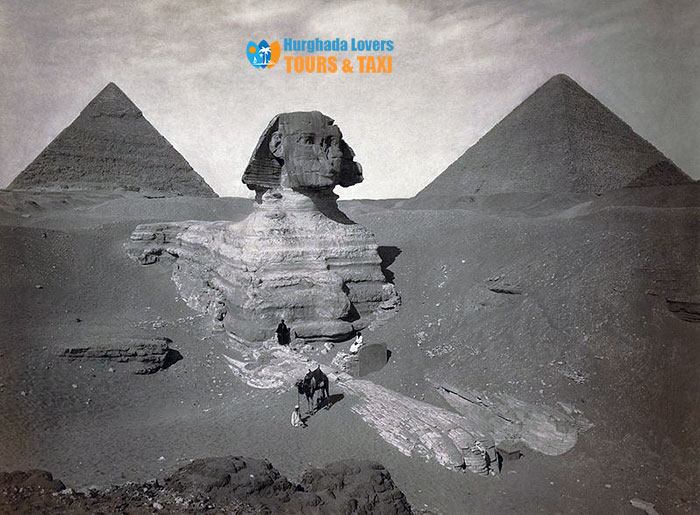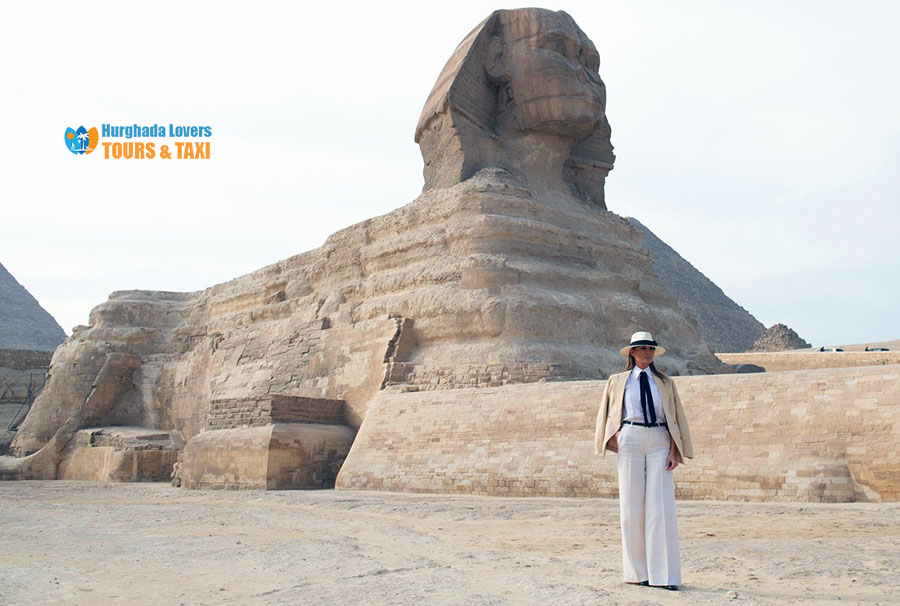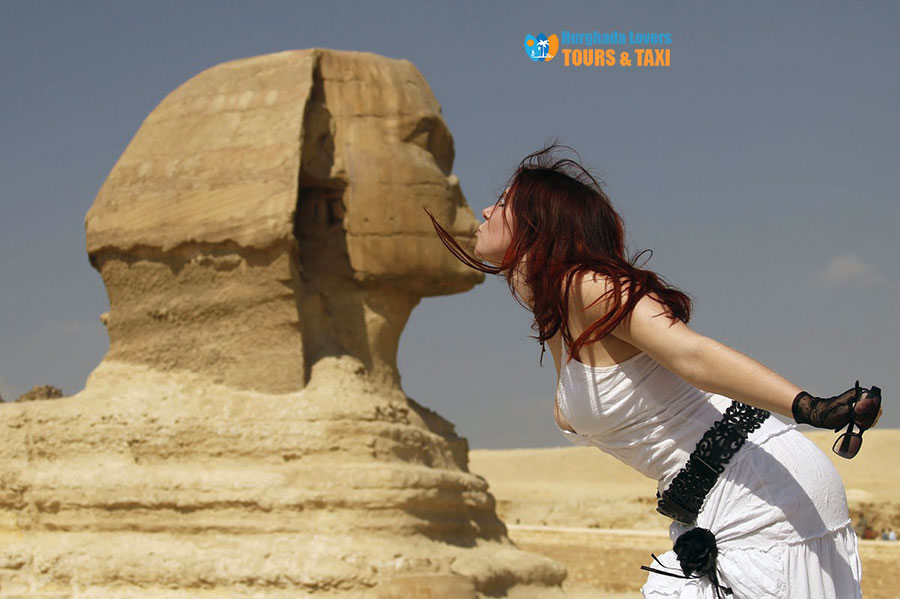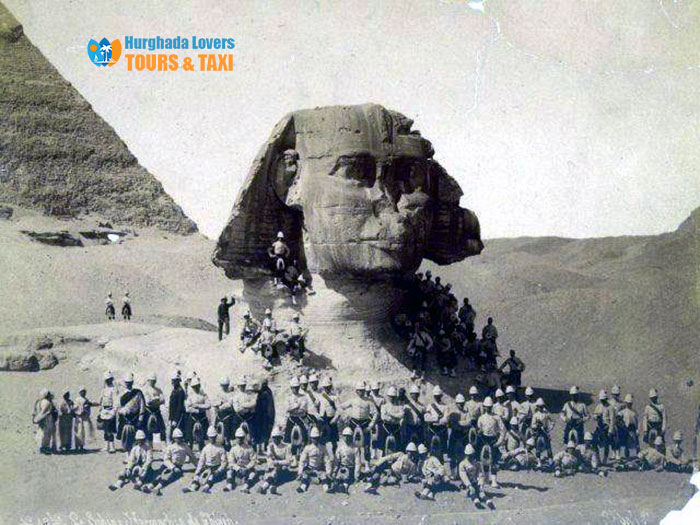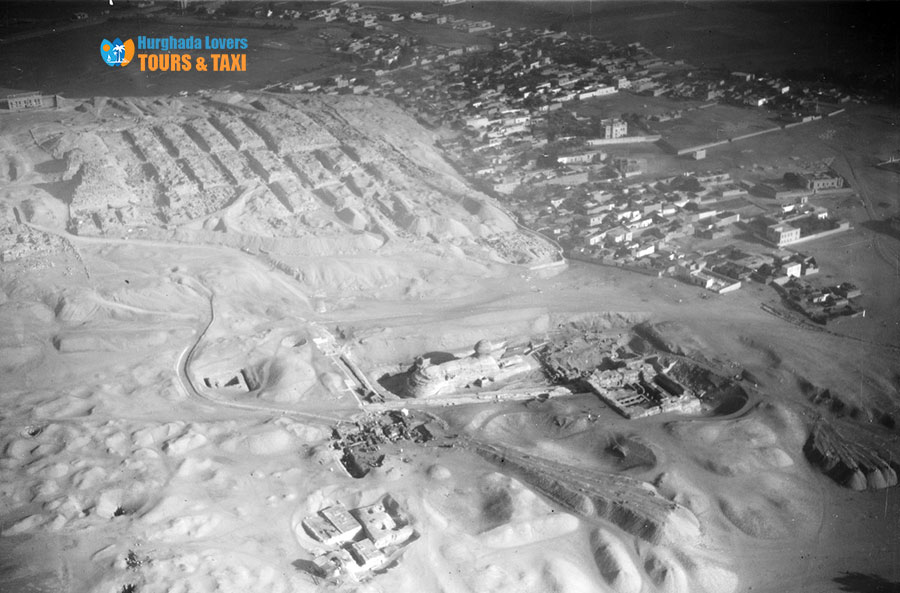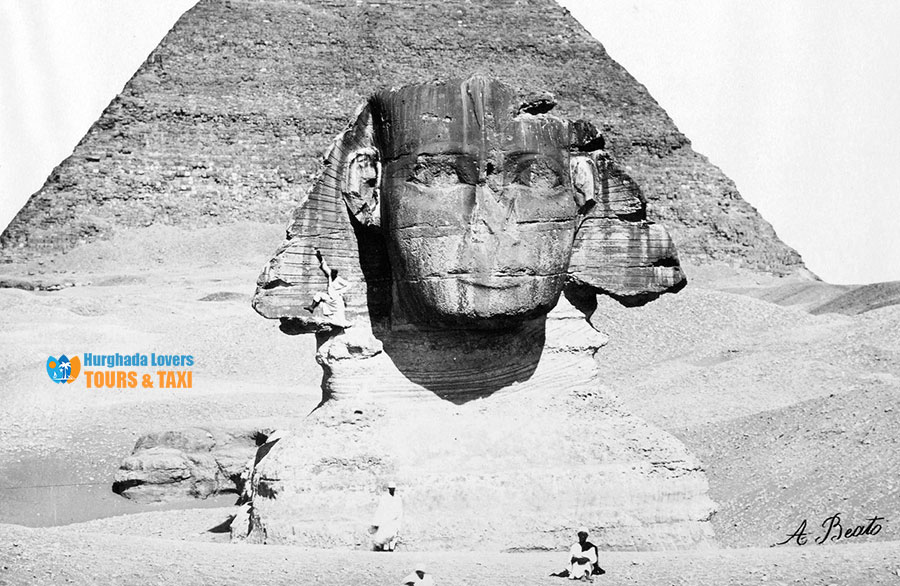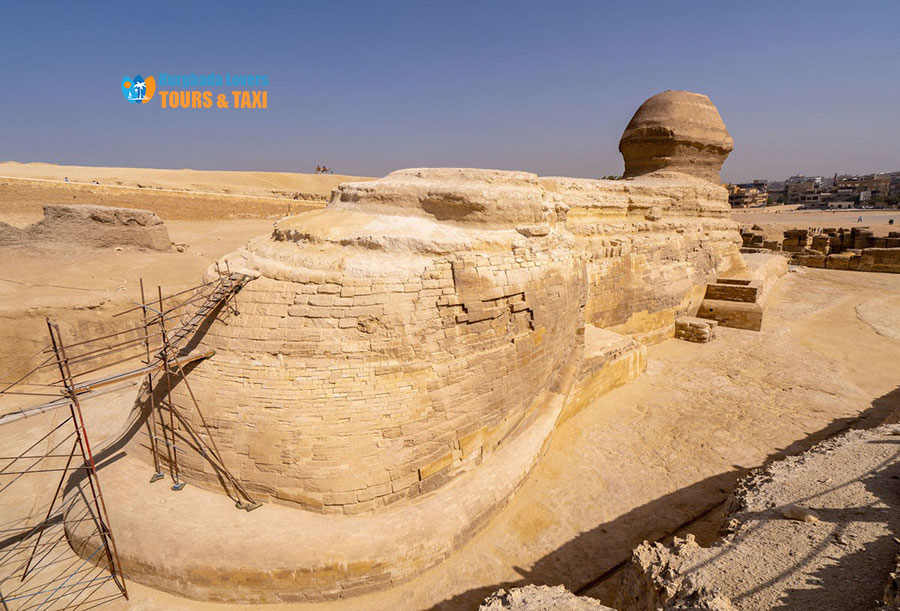The Sphinx of Giza – The Pyramids of Giza in Cairo, Egypt
Discover the history of the Pharaonic civilization “Ancient Egypt History” and the secrets of the ancient Egyptian civilization to build the most important tourist attractions in Giza and the ancient Pharaonic Egyptian Monuments in Cairo.
Information you did not know before about building the statue, the Curse of the Pharaohs associated with it, why it was given this name, what is the secret of the hole under its ear, which direction it looks at, and more about The Secrets of Pyramid Construction.
Learn about working and visiting hours, entry ticket prices, and more to start your tourist trip and visit tourist attractions in Cairo, in addition to visiting all tourist attractions in Egypt and Egypt Archaeological Sites.
The Sphinx of Giza Facts
Why was the Sphinx given this name?
The Sphinx is a word synonymous with the word “secret,” and in the Ancient Egyptian Language it means a lion with a human body. It may have been a mystery or a secret throughout its history.
Who built the Sphinx?
It was built in the era of King Khafre of the Fourth Dynasty of Egypt during the Old Kingdom of Egypt and is considered one of the most famous pharaoh kings throughout history..
Construction date: between 2558-2532 BC
It is the guardian of the gates of the underworld and is located in front of the pyramid of Khafre. The Sphinx was made of stone and its mission was to guard Egyptian Tombs.
During the era of The New Kingdom, the beginning of the rule of King Ahmose I and his wife, Queen Ahmose Nefertar, the most famous Pharaonic queen of Egypt “Female Pharaohs” from the Eighteenth Dynasty of Egypt, it was placed on both edges of the roads leading to the entrances to Egyptian Temples.
The Sphinx was carved in the southern Giza area and was added to the Rams Roads linking the Karnak Temple and the Luxor Temple in the city of Luxor “Thebes” in southern Egypt..
Which direction is the Sphinx looking at?
He looks to the East and became a symbol of the East and was worshiped in later eras. In the era of King Thutmose IV, its prestige was restored and it was repaired after it was covered with sand to hold the Coronation of the Pharaohs so that he could be the Pharaoh of Egypt in power in ancient Egypt “Ancient Egyptian Government“.
It was proven that its reform occurred after this king dreamed about it, and the dream was recorded in a painting engraved in the hands of the Sphinx called (Plate Dream), and became synonymous with the god (Hor Makhis), which means (Horus on the horizon), and it is likely that when the Arabs called him the Sphinx or Abu Al-Hol, this has something to do with the word (Hour), which changed in their tongue to a squint and then a hole.
as the God Horus estranged from The most famous ancient Egyptian deities – Ancient Egyptian gods and Goddesses in the Ancient Egyptian religion during the period of King Khafre.
The Sphinx is made of limestone (Ancient Egyptian Metallurgy), where sections of stone were found that were used in building the pyramids of Giza.
It was likely that it was originally covered with a layer of plaster and colored. Traces of the original colors are still visible next to one of his ears.
The length of the Sphinx is about 73.5 meters, its height is 20 meters, and its width is 14 meters, with its head facing east, indicating the development of the arts of Sculpture in Ancient Egypt and Architecture in ancient Egypt.
Is the Sphinx female?
His body is that of a human, his face is an embodiment of the Pharaoh Khafre, and the head of the statue is covered by the royal headdress called the mongoose, whose mission is to guard the site “Clothing in ancient Egypt”.
The body and head were carved from the same stone, while the legs were added during construction, and there are the foundations of a temple that was most likely built in the same period in the following eras.
He also had a long false beard, which is now broken and is located in The British Museum in London..
The length of the Sphinx:
Length: 73.5 meters
Front feet length: 15 metres
Width: 19.3 m
Height: 20 m
The secret of the opening under the ear of the Sphinx?
The traveler Howard Vis used many packages of dynamite to search and excavate the secret vaults in the Sphinx. Large holes formed in the head of the statue. Then he made a failed attempt to repair the head with cement..
Which caused a hole under the statue’s head that exists until now.
The story of the nose of the Sphinx
The Sphinx statue had a nose 100 cm wide, but until now the reason for the loss of the nose has not been discovered, but there are many efforts, including::
The nose was destroyed by the guns of the French campaign led by Napoleon Bonaparte.
The statue was built without a nose from the beginning..
“The Fasting One,” a Sufi who lived next to the statue, destroyed it.
Climate factors and erosion.
The truth about The Sphinx of Giza?
Archaeologists and Egyptology historians have been searching for the cause and reality of the statue, but so far no confirmed information has been found, but there are opinions including…
The statue as a design represents the wisdom of man and the strength of the lion of King Khafre.
King Khufu built the face of the Sphinx with the same details as his face, as a Pharaonic statue of King Khufu was found resembling the face of the Sphinx..
In ancient religious beliefs, it represents the worship of the sun god Hor-em-Akhet, meaning Horus on the horizon, which for the Egyptians represented the worship of the God Atum to worship the sun at sunset..
Many Pharaoh kings visited the statue, such as King Tutankhamun, who has Tomb of Tutankhamun | KV62 within the tombs of the Valley of the Kings, and King Ramses II of the Nineteenth Dynasty of Egypt, who has the Temple of Abu Simbel in Aswan and the Tomb of King Ramesses II | KV7 in the Boday of Kings and Emperor Septimius Severus..
The story of the statue
There is a statue of the Sphinx on the southeastern road of the Great Pyramid of Giza, “built by King Khufu,” in a relatively low valley. Some people are shocked when they see the Sphinx for the first time because they expect it to be very huge, but in reality it appears smaller in size compared to the pyramids..
The Sphinx was carved from a large rock stone. This rock represents part of the temple group in the valley attached to the middle pyramid of King Khafre..
Did you know that until 1926, the statue of the Sphinx was buried in sand up to its neck, and after the sand that was around it was removed, archaeological research confirms to us that the history of the Sphinx dates back to the days of Khafre, the owner of the second pyramid..
The Sphinx is one of the most important Pharaonic Egyptian Antiquities and part of Khafre’s pyramid group. It is a large quarry from which workers cut the stones needed to build the pyramids and private tombs, but in its middle remains a large block that they left in place, and the presence of this block spoils the second pyramid and its upward path..
King Khafre’s engineers made from this block a magnificent statue of the king in the image of a lion with a human head.
On the top of the Sphinx is a royal headdress, known as (Nims), and on both sides of its face, which represents the face of King Khafre himself..
Secrets of building The Sphinx of Giza:
It is hardly mentioned that the Sphinx, during the era of the New Kingdom, was considered a god of the dead and a guardian of the dead, as in the legends of the Pharaohs “Egyptian Mythology” and the stories of Ancient Egyptian Literature, and this is a characteristic that makes its location at the entrance to the cemetery very appropriate.
This characteristic may be due to the fact that the Sphinx, since the era of the Old Kingdom, was called Atum, the god of the setting sun, as we saw in the Pyramid Texts.
Perhaps the original idea was that the god-king was residing there on the western horizon like “Atum” and thus he became considered a protector of the dead in the west.
However, the relationship of the Sphinx to guarding the dead was the subject of fiercer insistence by the Egyptians of later eras, who venerated him by saying: “I protect your funerary shrine.”
I watch over your funerary chamber and repel the stranger who might enter, and bring down your enemies with their weapons, and expel the evil one from your grave, and destroy your enemies… They never come back.
We also note that the humanization of the king’s features in the double and triple statues of Menkaure was demonstrated with the utmost clarity in some of the sculpture works that followed the era of King Menkaure, who built the Pyramid of Menkaure.
This is confirmed by the head of the statue, which is believed to belong to King Shepseskaf, who is considered the highest.
The pinnacle reached by the art of sculpture in the Old Kingdom era was its ability to highlight the vital and human feelings in the features of the statue.
In addition, the transparency of the alabaster that was used as a material for sculpture gave this head the effect of feeling the pulse of life, when compared to other heads of royal statues dating from the same era, which are characterized by art’s adherence to formality more than its adherence to expressionism. This is despite the fact that these heads have It was carved with skillful art that adheres to extreme precision and indicates the development of Astronomy in ancient Egypt.
There is nothing more beautiful in the history of sculpture than the statue of Khafre made of diorite stone, which stands in the Cairo Museum.
This statue was ancient in the days of Praxtile, as old as Praxtile to us, and yet it passed through a period of time lasting fifty centuries, and then reached us without The calamities and misfortunes of time are almost affecting him.
This statue was made of the hardest and most inaccessible stones for humans, but it conveys to us in the most complete way possible the physical strength of the king (or artist), his authority, stubbornness, firmness of opinion, valor, and intelligence..
The ancient Egyptian sculptor followed some traditional rules derived from the religious beliefs of that era. It was observed in all the positions of the statues, whether they were standing, sitting on a chair, cross-legged, or sitting cross-legged, that the body and head faced the viewer and did not have any twisting..
It is a position that shows respect for the job, for oneself, and for the people. It has also been noted that in standing statues, the left leg advances over the right, with the body leaning on the right leg. The artist also placed some of the statues with false eyes made of different materials. The eyelids are made of copper or bronze, the whites of the eyes are made of white marble, and the pupils are made of rock crystal or shiny black stone, indicating the development of Ancient Egyptian science and the arts of Industry in ancient Egypt.
The story of the dream painting:
Between the front feet of the Sphinx there is a granite plaque on which King Thutmose IV inscribed, “He has the Tomb of Thutmose IV + Prince Amenemhat son of Thutmose III, and Princess Tentamun | KV43 within the tombs of the Valley of the Kings.” These are the details of the story of Thutmose’s dream and the story of the agreement between him and the Sphinx on this granite plaque, which exists to this day..
Over the centuries, the Sphinx was covered with sand and was removed from it several times.
The most famous removal is recorded on the “Dream Stele” located directly in front of the Sphinx, which was ordered to be placed by Pharaoh Thutmose IV between 1400-1390 BC..
The dream painting describes the promise King Tuthmosis IV received in a dream that he would become king if he removed the sand around the Sphinx, before he ascended to the throne of Egypt in 1401 BC..
Height: 144 cm.
Width: 40 cm.
Thickness: 70 cm.
In its upper part, there are two carved figures of Pharaoh Thutmose IV, to the right and to the left, offering offerings to the Sphinx..
Foreign Egyptologists and archaeologists took molds of the painting and prepared gypsum casts of them to translate it and interpret the hieroglyphs and drawings on it. One of those paintings that closely resembles the original is located in the British Museum in London..
the address:
The desert back in Giza Governorate
Visiting dates:
Daily 8:00 AM – 5:00 PM
Friday 8:00am-5:00pm
Entrance tickets to the Great Sphinx area:
Note: Facts and secrets of the history will be added soon…
Hurghada Excursions Lovers, Best Travel Agency in Hurghada to provide daily tours to visit the Tourist attractions of Luxor by Hurghada to Luxor Tours and Hurghada to Pyramids Trips. Book online when you come to Hurghada, El Gouna, Sahl Hashish, Makadi Bay, Soma Bay.
Great Sphinx of Giza Egypt History, Secrets, facts, location, age, inside…
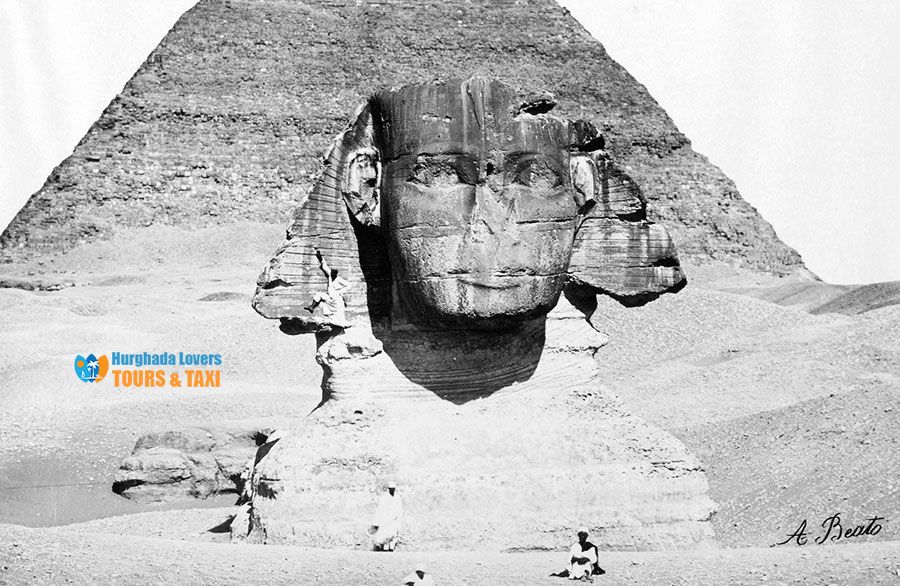
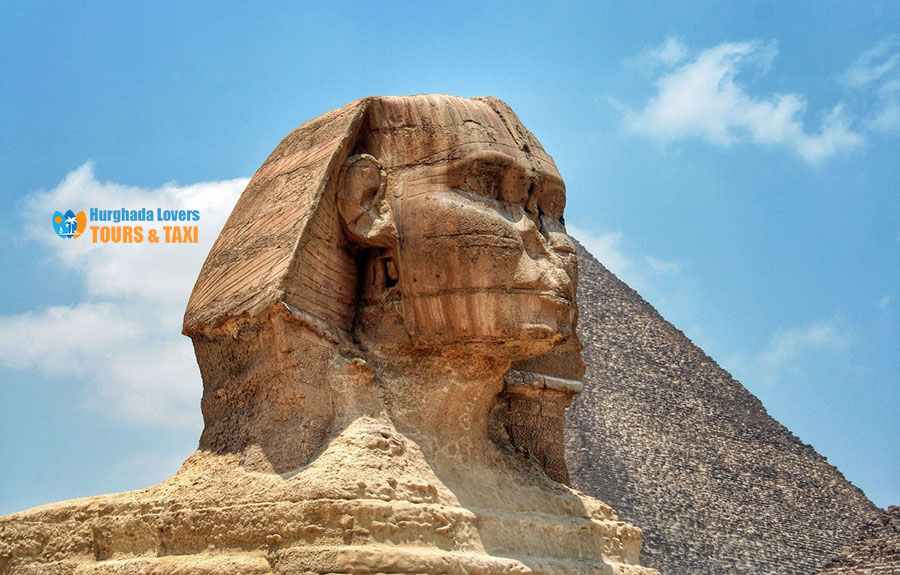
The Sphinx of Giza Cairo Egypt | the history and secrets of the ancient Egyptian civilization to build Cairo’s most important archaeological monuments and temples.

